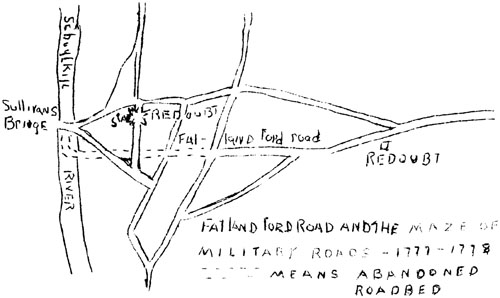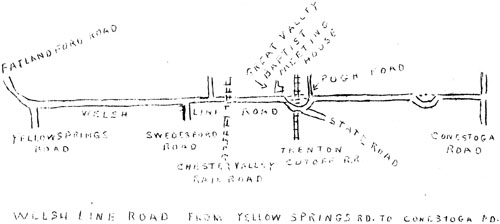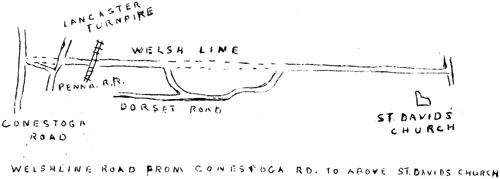|
Home : Quarterly Archives : Volume 2 |
Tredyffrin Easttown Historical Society |
|
Source: January 1939 Volume 2 Number 1, Pages 6–8 Additional notes on the Fatland Ford (Washington Lane) To fully appreciate Dr. McBee's paper on the present state of the so called Baptist or Valley Forge Line Road, it seems proper to recite some additional data, especially that taken from the original court records by Howard S. Okie, Esq. Riddle states that the crossing by way of Fatland Ford was over a continuation of Washington Lane, no longer open to the public from the Port Kennedy Road to the Schuylkill. The crossing was first to the upper end of Jenkins' Island, which was traversed to the lower end and thence to the opposite bank. (Cf. Valley Forge Guide and Handbook 1910). The topographical survey of Haupt and Franklin places the road substantially the same, a short distance west of Varnum's Quarters. A sketch found in DuPortail's quarters shows the same road in a nearly straight line from the base of Washington Redoubt to Jenkins' Island, but that part from the Port Kennedy Road to the river in a dotted line as an abandoned part, and the immediate vicinity a network of new military roads. Sullivan's Bridge a few rods below Jenkins' Island, was approached by two new roads. One passed a short distance east of the Star Redoubt and the other near Huntington Redoubt some distance west of the Star Redoubt. The evidence of a road or lane just east of Stephen's house (Varnum's Quarters) may have been an even more ancient way or only a farm lane.
Fatland Ford Road and the maze of military roads 1777-1778 So much for the extension of the road in Upper Merion; we will consider that part in Tredyffrin and Easttown. When David Llewellyn, surveyor, reported to the Provincial Council, May 5, 1724, on two roads in the Great Valley from Whiteland to the Swedes' ford, he found that the southernmost of Swedesford Road was "the most convenient for the publick, especially necessary for the congregation of the Baptists, and of least detriment to private persons," he had anticipated the same argument for the Welsh Line road which ran north and south through Tredyffrin and Easttown. The Welsh Line Road was so called by the early settlers because it followed the original Welsh surveyor's line (with a few short deviations) for nearly four of its five miles in the county. It doubtless replaced a series of lanes and cart roads bordering but not dissecting the original land grants -- an accomplishment easily obtained since the tracts were surveyed east and west of the Welsh line, and since none of the grantees desired their tracts divided by public roads, it gave great satisfaction.
Welsh Line Road from Yellow Springs Rd. to Conestoga Rd. This road "begins at or near the county line dividing Philadelphia (now Montgomery) from Chester near William Moore's Road (Nutt Road) at Mt. Joy by a black oak sapling in reputed line dividing said counties, then S. 28° W. across part of Nathan Evans' land 48 perches to a hickory stub, then S. 24° E. across the land of Nathan Evans and Henry John 113 (?) perches to a black oak, a corner of Daniel Walker's land." The above description forms a small section or arc which might properly be called the Fatland Ford Road, and the Welsh Line Road really begins at the eastern end of the Yellow Springs Road at the foot of the southern slope of Mt. Joy and the corner of Daniel Walker's land. "Then S. S. E. at a line dividing land of the Walkers from the land of John Havard and Samuel Richard, 300 perches to the Great Road leading from Isaac Melins to the Swedes' ford, then S. 70° E. at said road 34 perches, then S. 19° W. across corner of Isaac Walker's land and a corner of David John's land, 35 perches to a line dividing land of David John from the land of said Samuel Richard, then at said line S. S. E. 67 perches to a corner of the Baptist Meetinghouse ground." Here the road climbs directly to the crown of the South Valley hills rather than to follow the meandering of Nant y Ewig, as the Welsh called the creek and ravine directly south of their meetinghouse and the route latterly followed by the Devon road. "Then S. 15 1/20 E., 10 perches to a hickory stub, then S. 40° E. 8 perches to a corner of Abel Walker's land." The above deviation is above the meetinghouse, over a dirt road which perhaps has become more crooked on account of the iron ore mines worked more than half a century since by Nathaniel Jones, Charles Beaver, and Buck and King. "Then at dividing land of said Abel Walker and Thomas Simmons from land of Sharlow and Pleachwell S. S. E. 377 perches to Conestoga Road. Laid out May 1735 by Thomas Thomas, Lewis Lewis, Richard Richard, Stephen David, Edward Jones and Peter Elliott. Objections filed, but confirmed May 1735." Another section was added about the same date: "Petition to Court, Road recently laid out to accommodate Baptists in Easttown, necessary road to begin at the N. W. corner of John Thomas' field (Now the estate of Charles M. Lea) on the north side of the Conestoga Road and east of Sharlow's land, S. S. E. 550 perches to a corner of the Township of Newtown, then S. 4° W. 15 perches, W. S. W. 4° W. 15 perches, then W. S. 4 1/20 W. 12 perches to a white oak sapling in an old road."
Welshline Road from Conestoga Rd. to above St. David's Church The opening of this latter section from the Conestoga Road, according to court records, was contemplated as early as February 1723, when proceedings were begun before the Associate Justices of Chester County, but several petitions were presented by members of the St. David's Church and others, objecting to the laying out of the road. Yet the southern terminus was in the immediate vicinity of the church, and probably benefitted as many Episcopalians as Baptists. The former, however, had another road leading to their church, while the latter had only this road as a means of close approach to their meetinghouse, if we may exclude Deacon Jones' private lane from the west. |


